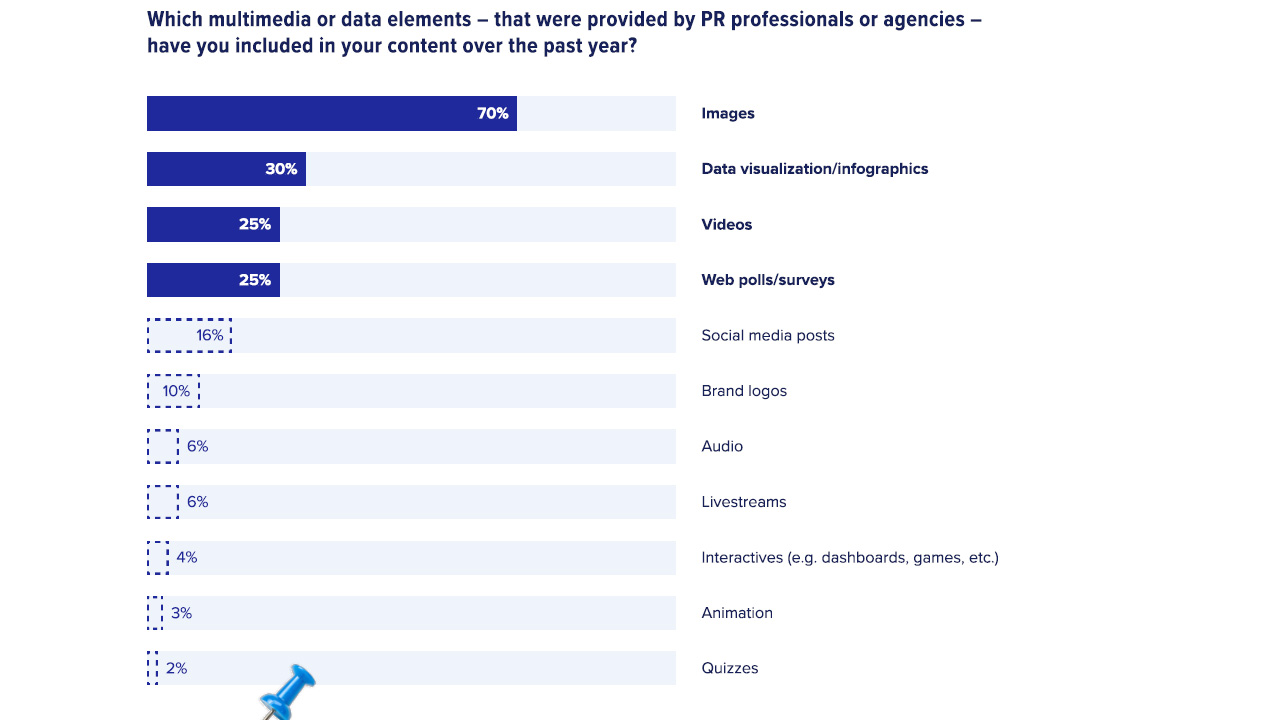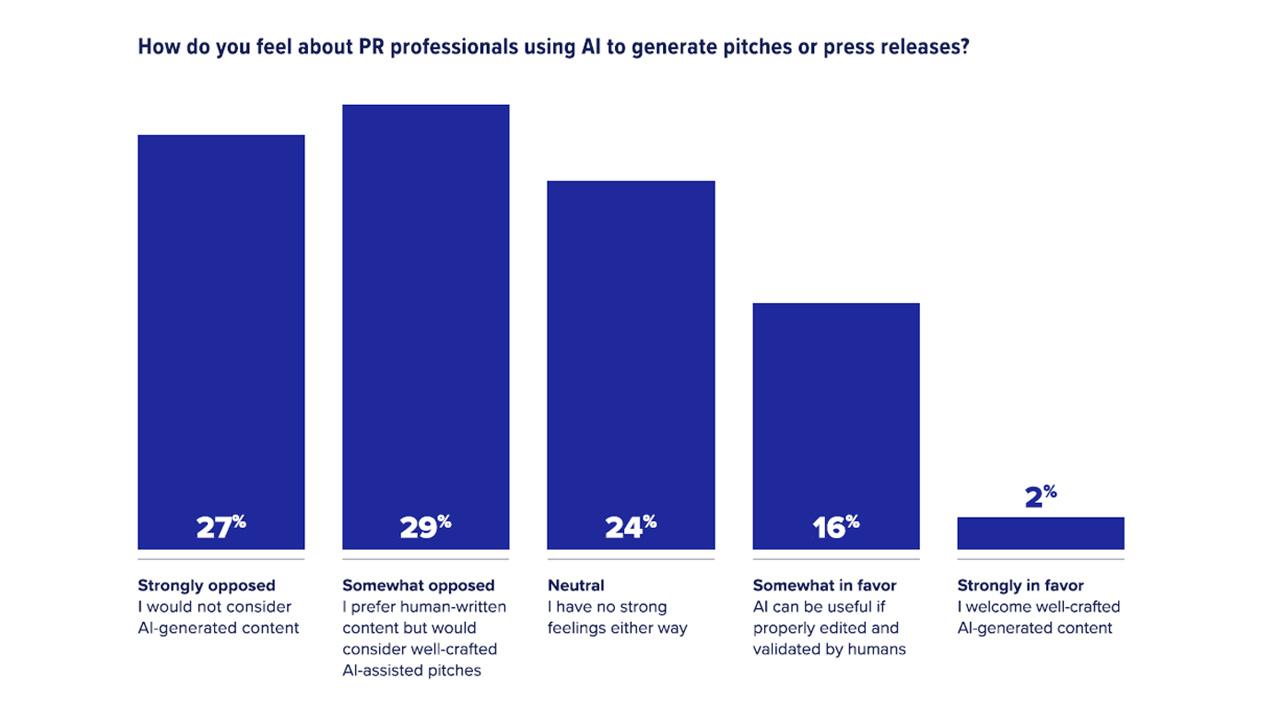Crafting a compelling pitch is at the core of public relations. Knowing how to pitch journalists successfully not only helps secure coveted earned media and create brand or campaign awareness, but it also helps build relationships with the media that can prove beneficial over time.
But as the most recent State of the Media Report shows, journalists’ inboxes are flooded with pitches – 1 in 2 told us they receive more than 50 pitches a week. It’s more important than ever that your pitch stands out and provides a good reason for a reporter to cover your story.
Of course, writing an attention-grabbing pitch is easier said than done. Fortunately, we have input from more than 3,000 journalists worldwide, participants from the above-mentioned 2025 State of the Media survey, that sheds light on exactly what they look for when deciding on what to cover (and what to ignore).
Read on for some data-backed insights on pitching journalists effectively.
Tips for Writing an Effective Journalist Pitch
1. Start with a Relevant, Newsworthy Angle
For a journalist to take notice of your pitch, it needs to offer a fresh, interesting angle that’s relevant to their readers. In fact, when asked in the most recent State of the Media survey what their biggest reason for rejecting a pitch was, the overwhelming response was a lack of relevance to a reporter’s audience or beat.
Before drafting your pitch, ask yourself these three questions:
- Why is this story relevant and important to the journalist’s audience?
- How does this tie into current events or trends?
- Does this move an existing story on or say something new?
Provide a clear, concise reason for a journalist to write about your story in the very first line of your pitch. Don't make them hunt for the hook, give it to them up front.
Go beyond just announcing a product launch, new hire, or industry award. Look for a unique angle that ties your news into a broader trend or topic the outlet's readers are interested in.
2. Lead with a Compelling Subject Line
The majority of journalists prefer to be contacted by email, yet their inboxes are inundated with pitches every week. So while email is the way to go with how you deliver your pitch, for it to stand out, your subject line needs to be both attention-getting and informative, clearly conveying what your journalist pitch is about.
Avoid gimmicky clickbait tactics (words like “urgent,” “groundbreaking,” or “breaking news”) and marketing jargon. Journalists don’t want PR pitches that sound like advertorials, with 70% saying they will reject a pitch that’s too promotional or lacks substance.
Your subject line is your chance to make a first impression, so make sure it grabs attention and doesn’t stray too far over 100 characters in length. Consider how to quickly identify the topic, like using [Travel] or [Tech]. And spark curiosity by hinting at the newsworthiness, like "New Data on..." or "Why X Trend is Growing."
Pro tip: Think like a journalist and don’t “bury the lede.”
3. Make Your Journalist Pitch Skimmable
Once you have journalists’ attention – thanks to your subject line – you need to keep it. As noted, journalists are slammed with email pitches, so your pitch should be easy to skim to allow the reader to quickly gather the facts they need. Use short paragraphs of two to three sentences and break up the text with bullet points highlighting key points.
For longer pitches – and don't go too long, most reporters want them in the 100-300 words range – think about using subheadings to help tell your story.
Your pitch should cover the who, what, when, where, and why of everything as briefly as possible. Include enough information for journalists to decide if it’s something they want to pursue further.
Wrap up with a clear call-to-action, like "I'm happy to answer any follow-up questions or set up an interview with our subject matter expert." Make it as easy as possible for them to take the next step if they’re interested.
4. Include Multimedia
According to our State of the Media Report, 20% of journalists say they are more likely to pursue a pitch that includes multimedia. Moreover, 70% of reporters said they used images provided by PR pros or agencies in the last year.
However, providing the right type of multimedia for the story you’re pitching, and the outlet you’re targeting, makes all the difference. (For instance, a print-only publication has no use for a video, just as a radio host has no use for an infographic.)

5. Offer Up Experts for Interview
Including a quote from an authoritative voice in your PR pitch can provide an added sense of credibility to the story you want journalists to cover. Offering up an interview with an industry thought leader can further pique their interest in your pitch.
In fact, journalists explicitly want PR professionals to connect them with relevant sources (cited by 63% of journalists) and set up interviews with industry experts (named by 38%).
Just be sure that your interview subject is both available and well-prepared for any interview requests, as journalists have tight deadlines to adhere to and thus need PR pros to deliver on what they promise – quickly.
6. Use Data to Enhance Your Story
Including data in your pitch is almost always a solid way to grab attention – in fact, journalists who participated in our State of the Media Report, ranked “data/original research” as the number one element of an ideal media pitch. Journalists, who must drive audience engagement in an ever-expanding media ecosystem, love getting their hands on original research, such as trends, market dynamics, industry insight, polls, and surveys.
The appeal of data is further evident with data visualizations/infographics ranking second as the form of multimedia (after images) most used by journalists in the last year.
Not only does data make for a more interesting pitch, but it also adds credibility to your story – and credibility builds trust in the eyes of a journalist's audience.
7. Think Carefully When Pitching with AI
When it comes to using AI for pitching journalists, it's worth proceeding with some caution. Although 27% of journalists say they are strongly opposed to PR pros using the tech, 42% are either neutral or show some favorability. Their biggest concern with PR professionals using AI? Creating content that will contain factual errors, cited by 72% of respondents.
AI can help streamline the pitching process, but it’s not without its flaws: any written communications you send out must be proofread, edited, and validated by human eyes.
Personalization matters, too. A generic, mass-mailed, AI-generated pitch can be spotted a mile away. Take the time to tailor any AI-assisted pitches to individual recipients to ensure you’re making an authentic connection.

8. Invest in a Quality Media Database
Knowing how to pitch journalists means nothing if you can't find the right reporter to send it to. That's where a quality media database can help you identify reporters who would be interested in covering your story. A media database is, as the name implies, a database of media contacts that run the gamut across industries, specialties, outlets, and regions. Most media databases include search filters to help you quickly home in on specific journalists to add to your media list, with additional intel on what topics they typically cover, what they’ve covered in the past, and their preferred methods of pitching – so you can craft more relevant pitches that are personalized to their interests.
CisionOne Outreach, for example, makes finding relevant media contacts to reach out to easy and intuitive. In addition to providing accurate and reliable contact information for media professionals across industries and outlets, it provides important details needed to personalize your messaging – from recent content they’ve published and topics they’re interested in to contact preferences and social media activity. You can even reach out to them directly from the platform.
Mastering how to pitch journalists takes skill, but following these media-backed strategies will help significantly improve your success rate.
Find out how CisionOne Outreach can help you perfect how to pitch to journalists. Speak with one of our experts.
Most Recent Posts
Cision Resources
-
E-books and Guides
Comprehensive how-to guides on strategy and tactics
-
Case Studies
What are other brands doing – and how can we learn from them?
About Simon Reynolds
Simon is the Senior Content Marketing Manager at Cision. He worked as a journalist for more than a decade, writing on staff and freelance for Hearst, Dennis, Future and Autovia titles before joining Cision in 2022.
